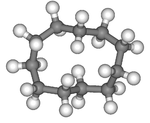Cycloundecane
Cycloundecane is a saturated cyclic organic compound with eleven carbon atoms forming a ring. It is classed as an alkane because it has only carbon and hydrogen and these elements are configured with C–H and C–C such that there is a chain of carbon atoms with hydrogens attached to them. For each of the carbon atoms in the chain there is a pair of hydrogen atoms such that the chemical formula is C11H22. The compound is stable, but it burns with sufficient ignition heat.
| |||
| Names | |||
|---|---|---|---|
| IUPAC name
Cycloundecane | |||
| Identifiers | |||
3D model (JSmol) |
|||
| ChemSpider | |||
PubChem CID |
|||
CompTox Dashboard (EPA) |
|||
| |||
| |||
| Properties | |||
| C11H22 | |||
| Molar mass | 154.29 g/mol | ||
Except where otherwise noted, data are given for materials in their standard state (at 25 °C [77 °F], 100 kPa). | |||
| Infobox references | |||
Variants of this compound, for example, bicycloundecane, have been proposed for use in conductors for electronic circuitry.[1]
References
- "Anisotropic conductive adhesive", United States Patent 6827880. Online copy Archived 2007-09-29 at the Wayback Machine
This article is issued from Wikipedia. The text is licensed under Creative Commons - Attribution - Sharealike. Additional terms may apply for the media files.

